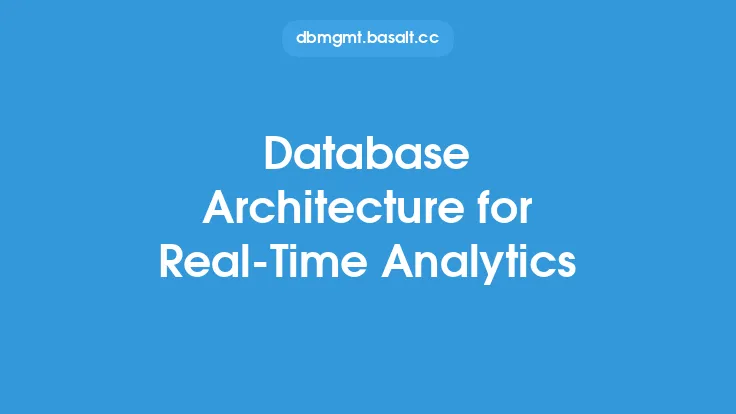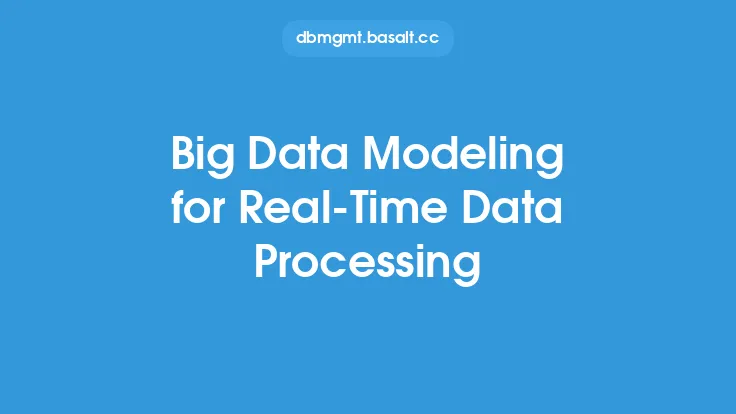Data warehousing is a crucial component of modern data analytics, enabling organizations to store, manage, and analyze large volumes of data from various sources. A well-designed data warehouse is essential for real-time data analytics, as it provides a centralized repository for data integration, processing, and analysis. In this article, we will delve into the design and implementation of data warehousing for real-time data analytics, exploring the key concepts, techniques, and best practices involved.
Introduction to Data Warehousing
Data warehousing involves the process of designing, building, and maintaining a repository of data that is optimized for querying and analysis. A data warehouse is a database that is specifically designed to support business intelligence activities, such as data analysis, reporting, and data mining. The primary goal of a data warehouse is to provide a single, unified view of an organization's data, which can be used to support informed decision-making.
Data Warehousing Architecture
A typical data warehousing architecture consists of several components, including:
- Source systems: These are the various data sources that feed data into the data warehouse, such as transactional databases, log files, and external data sources.
- Data integration layer: This layer is responsible for extracting data from the source systems, transforming it into a standardized format, and loading it into the data warehouse.
- Data warehouse storage: This is the central repository that stores the integrated data, which can be a relational database, a column-store database, or a NoSQL database.
- Data access layer: This layer provides a interface for users to access the data in the data warehouse, using tools such as SQL, OLAP, or data visualization software.
- Metadata management: This component manages the metadata associated with the data warehouse, such as data definitions, data lineage, and data quality metrics.
Data Modeling for Data Warehousing
Data modeling is a critical step in the design of a data warehouse, as it defines the structure and organization of the data. There are several data modeling techniques that can be used for data warehousing, including:
- Star schema: This is a data modeling technique that uses a centralized fact table surrounded by dimension tables, which provides fast query performance and efficient data storage.
- Snowflake schema: This is a variation of the star schema that uses additional dimension tables to provide more detailed data analysis.
- Fact constellation: This is a data modeling technique that uses multiple fact tables to provide a more comprehensive view of the data.
Data Warehouse Design Considerations
When designing a data warehouse, there are several considerations that must be taken into account, including:
- Data volume: The data warehouse must be designed to handle large volumes of data, which can be achieved through the use of distributed storage, parallel processing, and data compression.
- Data variety: The data warehouse must be designed to handle diverse data types and formats, which can be achieved through the use of data integration tools and data transformation techniques.
- Data velocity: The data warehouse must be designed to handle high-speed data ingestion and processing, which can be achieved through the use of real-time data integration tools and in-memory analytics.
- Data quality: The data warehouse must be designed to ensure data quality and integrity, which can be achieved through the use of data validation, data cleansing, and data normalization techniques.
Data Warehousing Tools and Technologies
There are several tools and technologies that can be used to design and implement a data warehouse, including:
- Relational databases: These are traditional databases that use a fixed schema to store data, such as Oracle, Microsoft SQL Server, and IBM DB2.
- Column-store databases: These are databases that store data in a columnar format, which provides fast query performance and efficient data storage, such as Apache Cassandra, Apache HBase, and Amazon Redshift.
- NoSQL databases: These are databases that use a flexible schema to store data, such as MongoDB, Couchbase, and RavenDB.
- Data integration tools: These are tools that provide data integration, data transformation, and data loading capabilities, such as Informatica, Talend, and Microsoft SQL Server Integration Services.
- Data analytics tools: These are tools that provide data analysis, data visualization, and reporting capabilities, such as Tableau, Power BI, and QlikView.
Real-Time Data Analytics
Real-time data analytics involves the ability to analyze and respond to data as it is generated, which provides organizations with a competitive advantage in today's fast-paced business environment. A data warehouse can be designed to support real-time data analytics by using techniques such as:
- Stream processing: This involves processing data in real-time as it is generated, using tools such as Apache Kafka, Apache Storm, and Apache Flink.
- In-memory analytics: This involves storing data in memory to provide fast query performance and real-time analytics, using tools such as SAP HANA, Oracle TimesTen, and Microsoft SQL Server In-Memory OLTP.
- Data caching: This involves storing frequently accessed data in a cache to provide fast query performance and real-time analytics, using tools such as Redis, Memcached, and Apache Ignite.
Best Practices for Data Warehousing Design and Implementation
There are several best practices that can be followed to ensure the successful design and implementation of a data warehouse, including:
- Define clear business requirements: The data warehouse must be designed to meet the business requirements of the organization, which involves defining clear goals, objectives, and key performance indicators.
- Use a structured design approach: The data warehouse must be designed using a structured approach, which involves defining the data architecture, data models, and data integration processes.
- Use data governance and quality control: The data warehouse must be designed to ensure data quality and integrity, which involves using data governance and quality control processes to validate, cleanse, and normalize the data.
- Use scalable and flexible technologies: The data warehouse must be designed to handle large volumes of data and provide fast query performance, which involves using scalable and flexible technologies such as distributed storage, parallel processing, and in-memory analytics.
- Provide ongoing maintenance and support: The data warehouse must be designed to provide ongoing maintenance and support, which involves monitoring data quality, performing data backups, and providing user support and training.





